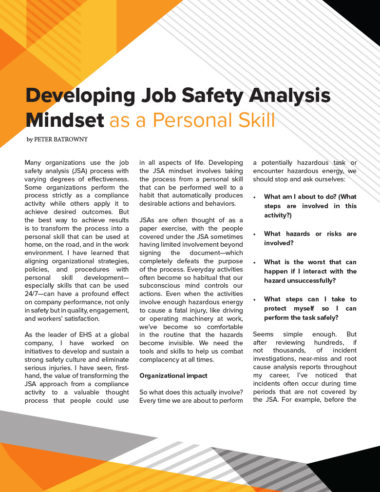By Peter A. Batrowny.
Many organizations use the job safety analysis (JSA) process with varying degrees of effectiveness.
Some organizations perform the process strictly as a compliance activity while others apply it to achieve desired outcomes. But the best way to achieve results is to transform the process into a personal skill that can be used at home, on the road, and in the work environment. I have learned that aligning organizational strategies, policies, and procedures with personal skill development— especially skills that can be used 24/7—can have a profound effect on company performance, not only in safety but in quality, engagement, and workers’ satisfaction.
As the leader of EHS at a global company, I have worked on initiatives to develop and sustain a strong safety culture and eliminate serious injuries. I have seen, firsthand, the value of transforming the JSA approach from a compliance activity to a valuable thought process that people could use in all aspects of life. Developing the JSA mindset involves taking the process from a personal skill that can be performed well to a habit that automatically produces desirable actions and behaviors.
JSAs are often thought of as a paper exercise, with the people covered under the JSA sometimes having limited involvement beyond signing the document—which completely defeats the purpose of the process. Everyday activities often become so habitual that our subconscious mind controls our actions. Even when the activities involve enough hazardous energy to cause a fatal injury, like driving or operating machinery at work, we’ve become so comfortable in the routine that the hazards become invisible. We need the tools and skills to help us combat complacency at all times.
Organizational impact
So what does this actually involve? Every time we are about to perform a potentially hazardous task or encounter hazardous energy, we should stop and ask ourselves:
- What am I about to do? (What steps are involved in this activity?)
- What hazards or risks are involved?
- What is the worst that can happen if I interact with the hazard unsuccessfully?
- What steps can I take to protect myself so I can perform the task safely?
Seems simple enough. But after reviewing hundreds, if not thousands, of incident investigations, near-miss and root cause analysis reports throughout my career, I’ve noticed that incidents often occur during time periods that are not covered by the JSA. For example, before the actual job begins or after it’s completed and workers return to retrieve tools or personal items.
Whether an organization performs JSAs to comply with regulations and company policies or because it perceives it to be a valuable part of the job planning process, encouraging people to employ the JSA as a thought process is a worthwhile initiative that could prevent injuries at times when JSA is not officially performed.
To start with, observe how JSAs are completed before a task/job begins. Is the document completed by one individual, read or reviewed with the team, and then signed? In other words, is it completed as a compliance task?
To achieve optimal results, the entire team needs to be involved and follow these three steps:
- List all the steps in the process
- Identify hazards and risks associated with each step (ask, “What is the worst that can happen?” for each hazard)
- Select appropriate mitigation for each identified hazard
Once these steps have been completed and a plan is developed to diminish the hazards, the results need to be documented. Discussing mitigation techniques in the context of the hierarchy of controls will ensure that proper emphasis is given to each of them, especially to those at the bottom of the pyramid, including PPE and administrative controls.
This behavior will become especially valuable when it’s fully developed into a habit. But in order to do so, we need to make an individual commitment to practice the skill. So it’s important to set up organizational systems in the workplace and encourage supervisors and leaders to support the JSA mindset.
Personal skill
Leaders and supervisors can encourage the development of the JSA mindset as a personal skill by recognizing and providing specific feedback when they observe it being used. Let’s use an example of a worker returning to a job site that requires fall protection after the crew is finished for the day. If a supervisor observes the person tying off, they can acknowledge this in the context of the JSA being used as a personal skill.
Once developed into a habit, the JSA mindset is a powerful tool that can be utilized 24/7. Personally, before I begin any task that involves potentially hazardous energy (cleaning the eavestroughs, for example), I perform a mental JSA to ensure I have the appropriate PPE and use the proper skills and techniques to accomplish the task safely. I store my ladder in the rafters of the garage, so the first step in my process is to review the potential risks when retrieving it.
When a task is performed infrequently or for the first time, we should review our mental JSA with a family member, friend or colleague to make sure there weren’t any steps or hazards missed, and that the mitigation techniques seem appropriate.
Developing the JSA into a personal skill will improve safety performance with all hazards and risks at home, at work, and on the road and sharing it with co-workers and family members will widen the safety net this skill provides.
Peter A. Batrowny is an industry-leading and global environmental health, safety, and physical security executive with a progressive career history and quantifiable track record of success. He has a consistent record of positioning programs and employees for success while bridging cultural divides and boosting engagement levels. A master of change, Peter is able to overhaul programs, processes, and procedures while rallying teams and gaining unprecedented buy-in.

Get the PDF version
You can download a printable PDF of the article using the button below.

